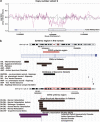Increased de novo copy number variants in the offspring of older males
- PMID: 22832608
- PMCID: PMC3309504
- DOI: 10.1038/tp.2011.30
Increased de novo copy number variants in the offspring of older males
Abstract
The offspring of older fathers have an increased risk of neurodevelopmental disorders, such as schizophrenia and autism. In light of the evidence implicating copy number variants (CNVs) with schizophrenia and autism, we used a mouse model to explore the hypothesis that the offspring of older males have an increased risk of de novo CNVs. C57BL/6J sires that were 3- and 12-16-months old were mated with 3-month-old dams to create control offspring and offspring of old sires, respectively. Applying genome-wide microarray screening technology, 7 distinct CNVs were identified in a set of 12 offspring and their parents. Competitive quantitative PCR confirmed these CNVs in the original set and also established their frequency in an independent set of 77 offspring and their parents. On the basis of the combined samples, six de novo CNVs were detected in the offspring of older sires, whereas none were detected in the control group. Two of the CNVs were associated with behavioral and/or neuroanatomical phenotypic features. One of the de novo CNVs involved Auts2 (autism susceptibility candidate 2), and other CNVs included genes linked to schizophrenia, autism and brain development. This is the first experimental demonstration that the offspring of older males have an increased risk of de novo CNVs. Our results support the hypothesis that the offspring of older fathers have an increased risk of neurodevelopmental disorders such as schizophrenia and autism by generation of de novo CNVs in the male germline.
Figures



Similar articles
-
High frequencies of de novo CNVs in bipolar disorder and schizophrenia.Neuron. 2011 Dec 22;72(6):951-63. doi: 10.1016/j.neuron.2011.11.007. Neuron. 2011. PMID: 22196331 Free PMC article.
-
De novo CNVs in bipolar affective disorder and schizophrenia.Hum Mol Genet. 2014 Dec 15;23(24):6677-83. doi: 10.1093/hmg/ddu379. Epub 2014 Jul 23. Hum Mol Genet. 2014. PMID: 25055870 Free PMC article.
-
De novo rates and selection of large copy number variation.Genome Res. 2010 Nov;20(11):1469-81. doi: 10.1101/gr.107680.110. Epub 2010 Sep 14. Genome Res. 2010. PMID: 20841430 Free PMC article.
-
Recurrent rearrangements in synaptic and neurodevelopmental genes and shared biologic pathways in schizophrenia, autism, and mental retardation.Arch Gen Psychiatry. 2009 Sep;66(9):947-56. doi: 10.1001/archgenpsychiatry.2009.80. Arch Gen Psychiatry. 2009. PMID: 19736351 Free PMC article. Review.
-
Disentangling the myriad genomics of complex disorders, specifically focusing on autism, epilepsy, and schizophrenia.Cytogenet Genome Res. 2011;135(3-4):228-40. doi: 10.1159/000334064. Epub 2011 Nov 12. Cytogenet Genome Res. 2011. PMID: 22085975 Review.
Cited by
-
Autism risk across generations: a population-based study of advancing grandpaternal and paternal age.JAMA Psychiatry. 2013 May;70(5):516-21. doi: 10.1001/jamapsychiatry.2013.1180. JAMA Psychiatry. 2013. PMID: 23553111 Free PMC article.
-
Parental Age and Differential Estimates of Risk for Neuropsychiatric Disorders: Findings From the Danish Birth Cohort.J Am Acad Child Adolesc Psychiatry. 2019 Jun;58(6):618-627. doi: 10.1016/j.jaac.2018.09.447. Epub 2019 Feb 27. J Am Acad Child Adolesc Psychiatry. 2019. PMID: 30825496 Free PMC article.
-
Non-telomeric epigenetic and genetic changes are associated with the inheritance of shorter telomeres in mice.Chromosoma. 2013 Dec;122(6):541-54. doi: 10.1007/s00412-013-0427-8. Epub 2013 Jul 18. Chromosoma. 2013. PMID: 23864360
-
"Selfish spermatogonial selection": a novel mechanism for the association between advanced paternal age and neurodevelopmental disorders.Am J Psychiatry. 2013 Jun;170(6):599-608. doi: 10.1176/appi.ajp.2013.12101352. Am J Psychiatry. 2013. PMID: 23639989 Free PMC article. Review.
-
Transposon insertion profiling by sequencing (TIPseq) identifies novel LINE-1 insertions in human sperm.J Assist Reprod Genet. 2023 Aug;40(8):1835-1843. doi: 10.1007/s10815-023-02852-6. Epub 2023 Jun 13. J Assist Reprod Genet. 2023. PMID: 37310664 Free PMC article.
References
-
- Hultman CM, Sandin S, Levine SZ, Lichtenstein P, Reichenberg A.Advancing paternal age and risk of autism: new evidence from a population-based study and a meta-analysis of epidemiological studies Mol Psychiatryin press (e-pub ahead of print). - PubMed
-
- Malaspina D, Harlap S, Fennig S, Heiman D, Nahon D, Feldman D, et al. Advancing paternal age and the risk of schizophrenia. Arch Gen Psychiatry. 2001;58:361–367. - PubMed
-
- Frans EM, Sandin S, Reichenberg A, Lichtenstein P, Langstrom N, Hultman CM. Advancing paternal age and bipolar disorder. Arch Gen Psychiatry. 2008;65:1034–1040. - PubMed
-
- Vestergaard M, Mork A, Madsen KM, Olsen J. Paternal age and epilepsy in the offspring. Eur J Epidemiol. 2005;20:1003–1005. - PubMed
Publication types
MeSH terms
Grants and funding
LinkOut - more resources
Full Text Sources

